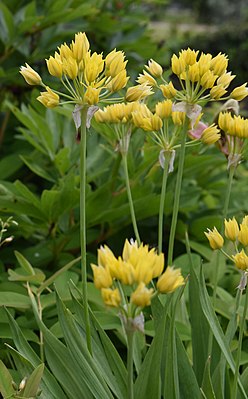Gold leek
| Gold leek | ||||||||||||
|---|---|---|---|---|---|---|---|---|---|---|---|---|

Gold leek ( Allium moly ) |
||||||||||||
| Systematics | ||||||||||||
|
||||||||||||
| Scientific name | ||||||||||||
| Allium moly | ||||||||||||
| L. |
The gold leek ( Allium moly ), also known as summer ramson or yellow ramson , is a species of the genus leek ( Allium ) within the amaryllis family (Amaryllidaceae).
description

Vegetative characteristics
The gold leek is a bare, perennial herbaceous plant . A spherical, egg-shaped onion with a gray, coarse, wrinkled and holey skin is formed as a persistence organ . The vegetative propagation happens through secondary bulbs.
The one to two basal, parallel- veined leaves are 12–50 millimeters wide and lanceolate, flabby, flat and green- glazed in color. The leaves are shorter than the flower stem and are present during the flowering period.
Generative characteristics
On an inflorescence shaft up to 30 centimeters long there is a hemispherical, dold-like inflorescence with a translucent whitish to brownish membrane. The flower stalks are 1–3 inches long, slightly longer to three times as long as the flowers.
The hermaphroditic flowers are radially symmetrical , threefold and wide-belled. The six identical bloom bracts are golden yellow with a green central stripe on the outside and 6-10 millimeters long, free, elongated-elliptical, pointed or blunt. The six stamens are shorter than the bracts and do not protrude from the corolla; the anthers are yellow. The stylus usually does not protrude beyond the stamens.
The flowering time is in the natural location in May, in Central Europe it extends into July.
The number of chromosomes is 2n = 14.
ecology
The gold leek is a geophyte .
Occurrence
In the first publication, Carl von Linné mentions the distribution: “Hungaria, Baldo, Monspelii”, i.e. Hungary , Monte Baldo and Montpellier . The gold leek is originally found in the western Mediterranean region ( southern France , eastern Spain , Morocco , Algeria ). It thrives on dry edges and on limestone rubble. Around 1900 it was already isolated in Mühlhausen in Thuringia .
It is possible that the gold leek is spreading in Central Europe as a cultural refugee from places where it was planted by humans.
Systematics
The first publication of Allium moly was made in 1753 by Carl Linnaeus in Species Plantarum , Tome I, p 301. The epithet moly hereafter Greek miracle herb that Hermes against the witchcraft of Kirke used.
The species Allium moly belongs to the Molium WDJKoch section from the genus Leek ( Allium ).
Since 2015, Allium moly has been divided into two subspecies:
- Allium moly L. subsp. moly (Syn .: Allium aureum Lam. , Allium flavum Salisb. ): The nominate form is larger (19–30 cm), has several wider and longer leaves of grass-green color and floriferous (9–16 flowers) inflorescences; except in the area of the subsp. glaucescens in the entire area of the species.
- Allium moly L. subsp. glaucescens P.P.Ferrer, R.Ferrer, E. Laguna & Guara : It was first described in 2015. It probably only occurs in a small area in the Valencia area, is smaller (15–24 cm), has only a single leaf that is shorter and narrower and of a glaucous color, and differs from little-flowered (3-11 flowers) inflorescences regarding the ingredients.
use
The gold leek is cultivated as a hardy and drought-tolerant ornamental plant, which is also suitable as a cut flower. The very aromatic leaves can be used like wild garlic in the kitchen. Because of the later flowering period, they are still available when wild garlic has already faded and its leaves have wilted.
supporting documents
Individual evidence
- ↑ Thomas Meyer, Michael Hassler: data sheet with photos and identification key for Mediterranean and Alpine flora .
- ↑ a b c d e Paul Ascherson & Paul Graebner: Synopsis of the Central Aural Flora. Third volume, Wilhelm Engelmann, Leipzig 1905–1907, pp. 156–157 [07/25/1905] ( digitized version ).
- ↑ a b Christof Nikolaus Schröder: data sheet at CNSflora .
- ^ A b Jean-Marc Tison, Bruno de Foucault: Flora Gallica. Flore de France . Biotope Editions, Mèze 2014, ISBN 978-2-36662-012-2 .
- ↑ Allium moly in Tropicos.org. In: IPCN Chromosome Reports . Missouri Botanical Garden, St. Louis.
- ^ A b Carl von Linné: Species Plantarum. Volume 1, Lars Salvius, Stockholm 1753, p. 301 ( digitized version ).
- ↑ Allium moly in Tropicos.org. Missouri Botanical Garden, St. Louis, accessed August 15, 2021
- ↑ Pedro Pablo Ferrer-Gallego, Raúl Ferrer-Gallego, Emilio Laguna Lumbreras, Miguel Guara-Requena: Allium moly subsp. glaucescens (Asparagaceae), a new subspecies from the Iberian Peninsula. In: Phytotaxa , Volume 192, Issue 1, 2015, pp. 35–43. DOI: 10.11646 / phytotaxa.192.1.4
literature
- Jean-Marc Tison, Bruno de Foucault: Flora Gallica. Flore de France. Biotope Editions, Mèze 2014, ISBN 978-2-36662-012-2 .
Web links
- Allium moly at Plants For A Future
- Thomas Meyer: Data sheet with identification key and photos at Flora-de: Flora von Deutschland (old name of the website: Flowers in Swabia ) .
- Datasheet with photos and distribution in France .
Historical literature
- Georges Rouy: Flore de France , Tome XII, 1910, p. 373 ( digitized version ).

